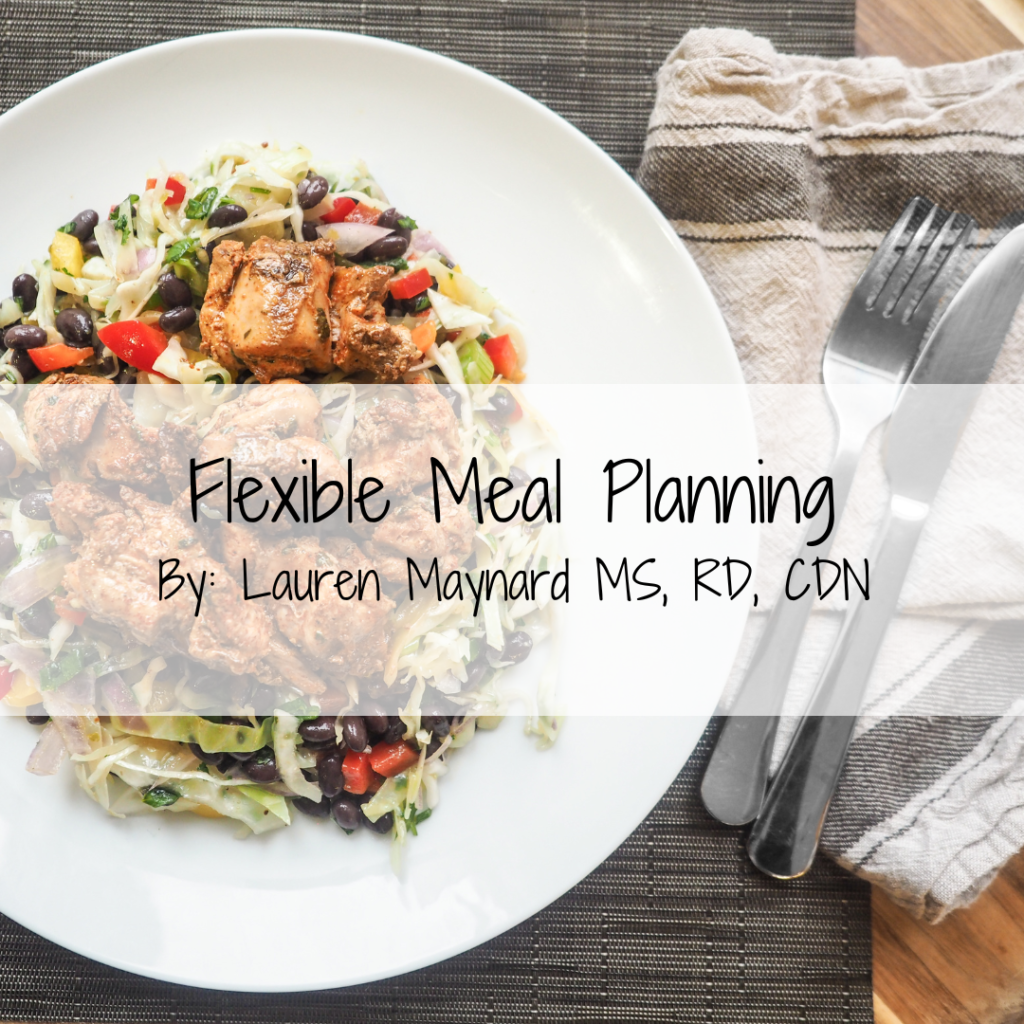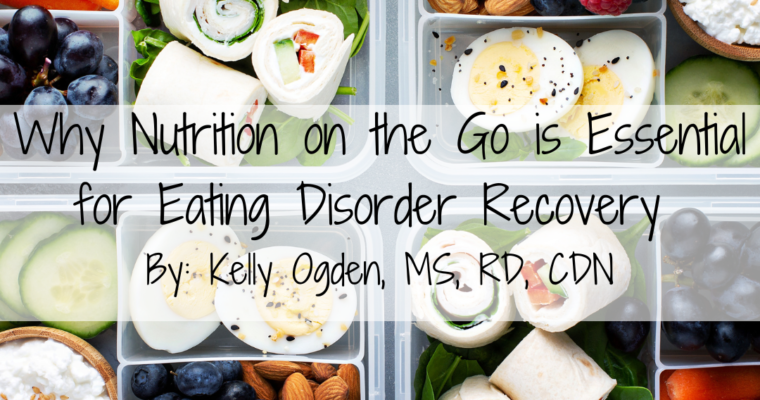
There is a common assumption that when going to see a Registered Dietitian, you will leave with a rigid food plan. At Pearls of Nutrition, we prioritize spending time planning meals with our clients and in a way that is individualized for each person. We understand that everyone’s relationship to food, or work hours, family life, health concerns, and budget looks different. Prioritizing all of these areas helps to step away from diet culture pressure and into building an intuitive relationship with nutrition. It may seem like meal planning and Intuitive Eating go against each other, but this is where we bring in the idea of flexible meal planning. This post may be a great place to start exploring your relationship to both Intuitive Eating and meal planning!
What actually is meal planning?
The aim of meal planning is to spend some time brainstorming ideas for upcoming meals. The goal being to minimize the likelihood of needing to make an “in the moment” decision on what to eat, when you are already really hungry. This offers a way to enhance the eating experience by having food on hand and ideas of how to use it, without feeling chaotic or rushed. We can make this as simple or complex as we want.
Some, particularly those early on in recovery from an Eating Disorder, may require a higher level of structure around meal planning. This higher level of structure can mean planning the specific foods you will have at each meal or snack daily Flexible meal planning on the other hand allows for some forethought to meals and snacks, but not necessarily assigning them to a specific day of the week. This allows there to be food available, but you then have the flexibility to choose when you want to eat it. The goal of flexible meal planning is to help you be prepared, more in tune with what you want, and to prevent any guilt or shame that may arise if each meal did not happen exactly how or when it was originally intended. Other benefits of a flexible meal planning include:
- Saving money by minimizing the frequency of eating out
- Reducing food waste, as the food you are buying has an intention/purpose
- Reducing daily stress/time when it comes to deciding what to eat each day
- Reduced stress grocery shopping as you will go in with intention
- Incorporating nutrient dense foods as often as possible to support out health
- Reduce missed/skipped meals that can heighten levels of hunger and lead to binging/overeating
Where to Begin
Meal planning truly begins the moment you start to think about any aspect of a meal. It does not have to begin with a ton of new Pinterest recipes or throwing out everything you may know about food. Sometimes we forget that meal planning is meant to provide ease to eating, not increase stress. So how do we get there?
Here are a few initial thoughts to ask yourself:
- What foods do I actually like?
- Am I frequently skipping meals?
- Is there one area I want to focus on?
- What makes financial sense?
From there, the following steps can be helpful to enhance the meal planning process:
Look at your upcoming schedule
Take some time to look at your calendar for the upcoming week. This will help to determine the time you have (or want) to spend in the kitchen and grocery shopping. If you have a really busy week, simple meals may be the most reasonable. We’ll talk more about busy night plans and this is where they can really come in handy. When you have a bit more time, maybe that’s when you pull up that Pinterest board and try out a new recipe or two.
Kitchen shop before you grocery shop
Before sitting down to create meal ideas, do a quick pantry, refrigerator and freezer search to see what items you have. This may spark a few meal ideas and minimize buying duplicate items. For example, if you have some vegetables in the freezer, a box of rice in the pantry, and some soy sauce in the refrigerator, a stir fry night may sound doable and you just have to purchase a protein to complete the meal.
Write down meal ideas
Get comfy with your favorite beverage and spend 5-10 minutes creating meal ideas for the week. This is where I would recommend focusing on one mealtime first. If dinner tends to be very stressful or if you consistently skip lunch, incorporating some flexible planning and meal ideas here makes sense. You can do this in various ways, such as writing on a sheet of paper, using the notes app on your phone or even a simple sticky note.
You don’t need to reinvent the wheel here, you can keep your planning simple. Consider what you feel confident in making and what you/your family really enjoy and start by building your list around these ideas. Maybe establishing themed nights such as Pasta Monday, Taco Tuesday, or Soup and Salad Friday is a helpful default each week. Again, when you have the time in your week, feel free to pull up that Pinterest board of recipe ideas or a recipe book you have been wanting to use. These can be your fun/new meal ideas to try every so often- you don’t need to try 5 new meals each week. If you are having trouble completing this step on your own, ask your Registered Dietitian for help. The two of you can work together to come up with a list of meal ideas that you can continue to use moving forward.
What about busy nights and “who’s got time for cooking” meal ideas? We all need them. We’re busy humans and its unlikely we have time to make brand new meals or cook from scratch 100% of the time. Using leftovers, takeout, freezer meals, or maybe sandwiches as needed can be a lifesaver. Remember, the goal is daily nourishment, not having an Instagramable dinner pic. Planning for 1-2 of these busy nights each week allows you to have quick food options available and meet your goal of taking care of yourself.
Make your grocery list
It can be helpful as you are going through your meal ideas to also have a separate section of notes where you begin to write down ingredients that you need. Breaking these items into different categories or aisles of the store, such as produce, dairy, protein, frozen, starches/grains, drinks, snacks etc. can be a helpful organizing tip. This can help to minimize time spent in the grocery store.
Do we always need fresh everything? No. Having a combination of fresh, frozen and prepared items on hand is a great way to minimize waste and also help your future self. Not only will this offer some ease in the actual making of the meal, but it will also increase the likelihood of nutrient dense and satisfying meals, by having multiple food groups available.
Grocery shopping
Going shopping can be one of the more overwhelming and dreaded parts of meal planning. Again, thinking about what your week looks like is helpful. Does a weekend day look better to get to the store or maybe a weeknight after work? You may find dedicating this task to another family member works better or using instacart/grocery pickup is a lifesaver. Going to the store during non-peak hours can also be a huge help- before 9 am, after 7 pm, or, here in Rochester- anytime the Bills are on.
The frequency of grocery shopping can be an important aspect to think about as well. If planning and shopping for an entire week feels overwhelming, start off with 1-2 days at a time with smaller grocery hauls. It may eventually feel easier to do a larger trip every 1-2 weeks to minimize trips to the store.
Barriers to meal planning:
“What if I don’t want what I have planned for that day?”
“I never stick to what I have planned and end up ordering take out, so it’s a waste of time”
“I don’t want to spend hours planning and shopping”
Hey, I hear ya! That just makes you a human who has a life outside of only planning what you are going to eat next.
In order to minimize rigidity and an “all or nothing” mindset around meal planning, it can be helpful to think about our why again – why plan out meals? The reason can be different for everyone, but returning to this why when you are feeling frustrated can help you push through. Using flexible meal planning can be especially helpful when you experience the urge to forgo your plan. Maybe the chili you were going to make that night doesn’t sound appealing but the roasted chicken over potatoes and vegetables on the agenda for later in the week may hit the spot. Flexible planning gives a general outline for the week, which can feel really supportive and at the same time will not lead to feeling like a failure if it does not work out “perfectly.”
When you aren’t feeling up for what you planned, it can sometimes be helpful to remember the Rolling Stones- you can’t always get what you want. For example, if you have strong goals around reducing takeout to save money you may find yourself itching for takeout but unable or unwilling to do so. That’s okay! You will survive without the instant gratification of takeout! Sometimes we just need to remind ourselves of this. Make a note of what you are craving on your meal plan list or note so that you can plan for it on a future week when you don’t already have food in your fridge and can fit the cost into your budget.
Planning and shopping is a skill like any other, when you are new at it or it is intimidating to you, it’s definitely going to take you longer. The more you practice this skill the easier it will become over time. Saving meal plans and grocery lists from week to week can be a great way to ease the time it takes to meal plan. If you have a stack of 5 past weeks of plans and lists and find yourself not up for meal planning that week you can simply reuse one of your old plans. Many of our clients keep a folder on top of their fridge or in their kitchen with recipes they enjoy and old meal plans to be able to quickly reference.
How does Intuitive Eating fit in?
Listening to what sounds good and discovering what you really enjoy are essential parts of honoring your hunger and increasing satisfaction with meal planning. The reality is, even when we are intuitively listening to our hunger cues, sometimes we feasibly can not have what sounds good in that moment. Eating based on cravings 100% of the time is extremely difficult, likely not practical, and may interfere with you meeting your nutrition needs. For example, if you planned to have spaghetti for dinner and really want a steak, it may not be realistic to have at that moment if you didn’t purchase steak or cannot go out to dinner. It’s a privilege to be able to eat what we want at any given moment, and unfortunately is not the reality for most! Eating what is practical in that moment is choosing to nourish your body with the food you have and honoring a normal relationship to eating. Every meal may not be the most wonderful and delicious meal you’ve ever had, but that doesn’t mean it is not intuitive or nourishing. It can be helpful to write down the craving you are experiencing to make sure you plan for it in the future. This will help you to meet your cravings while also being mindful of food waste and your budget. A lack of variety can also be a big factor in increased cravings. If you are on your third night of eating the same meal and you are sick of it, that may tell you to kick up the variety next week or only plan to have the same meal twice in a week.
If you are in the process of healing your relationship with food and exploring intuitive eating, moving to more flexible planning may feel extremely difficult and like you have let go of some control. I get it – structure feels safe. We tend to lean into structure when we feel unsure or out of control in order to create safety and to ultimately feel better. At the same time, those with goals around Intuitive Eating really see the benefit of listening to what sounds good at the time rather than having a prescribed daily plan. This is where flexible planning really comes in handy- have a list of some ideas, then on that day decide what you feel like. We do not need to avoid all planning. The goal is to minimize thoughts about what you should be eating and instead start to incorporate what you would like to eat. There is also a lot of mixed messaging from diet culture on what to eat, which takes us further away from listening to what our body actually wants. You can cue into your own wants/needs by asking yourself questions like:
- What sounds good right now?
- Do I want something hot or cold?
- What kind of texture am I interested in?
- What flavors sound enjoyable?
- What color combinations do I want to see on my plate?
Need help?
Our goal as dietitians is to work through each person’s relationship to food, listen to what may or may not be working, take into consideration any medical concerns, and then offer support, recommendations, and education. We prioritize what you actually enjoy plus getting the most nutrient dense foods we can because that is what makes us smile from the inside! If you are actively recovering from an eating disorder, you may benefit from a more specific and therapeutic recovery meal plan. Designing a recovery meal plan is best supported alongside a dietitian and we would love to be a part of your recovery! With all things said and done, it can be helpful to spend some time with a dietitian talking about meals in greater detail. Afterall, we do love talking about food! In a session, we may talk about what nutrient density means, what foods you enjoy and how to build meals using both of these frameworks. The most important thing to remember is that we have to eat, so let’s work together on making it feel as enjoyable as possible.
Other Resources:
- Kids Eat In Color – is a great resource for picky eaters!
- The “54321” Grocery Shopping Method
- Meal Planning with Intuitive Eating
- Intuitive Eating on a Budget


